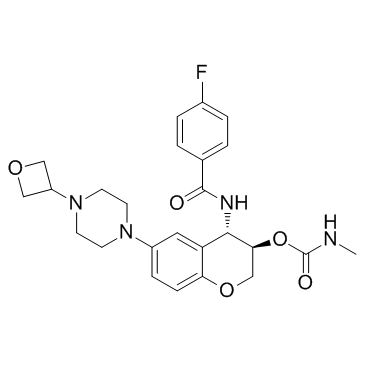| Cas No.: | 1373215-15-6 |
| Chemical Name: | (3R,4S)-4-(4-fluorobenzamido)-6-(4-(oxetan-3-yl)piperazin-1-yl)chroman-3-yl methylcarbamate |
| Synonyms: | LY3000328 |
| SMILES: | O.O=CC([C@@H](NC([C@H](CC1=CC=CC=C1)NC(OCC1=CC=CC=C1)=O)=O)CC(C)C)=O |
| Formula: | C25H29FN4O5 |
| M.Wt: | 484.528 |
| Sotrage: | 2 years -20°C Powder, 2 weeks 4°C in DMSO, 6 months -80°C in DMSO |
| Publication: | [1]. Jadhav PK, et al. Discovery of Cathepsin S Inhibitor LY3000328 for the Treatment of Abdominal Aortic Aneurysm. ACS Med Chem Lett. 2014 Aug 27;5(10):1138-42. [2]. Payne CD, et al. Pharmacokinetics and pharmacodynamics of the cathepsin S inhibitor, LY |
| Description: | LY-3000328 is a potent, highly selective cathepsin S inhibitor with IC50 of 7.7 nM; dispalys >500-fold selectivity over cathepsin L, cathepsint K, cathepsin B, and cathepsin V; shows efficacy in a CaCl2-induced AAA (Abdominal Aortic Aneurysm) in vivo model.Other IndicationPhase 1 Clinical |
| In Vivo: | The efficacies of LY3000328 is studied in a mouse model of abdominal aortic aneurysm (AAA). In this model, inflammation is induced using CaCl2 applied to the ablumenal surface. It is shown that features of the disease state in this model resemble those of human AAA. LY3000328 exhibits a dose-responsive aortic diameter reduction at 1, 3, 10, and 30 mg/kg. At the lowest dose of 1 mg/kg of LY3000328, the aortic diameter is reduced by 58%, then 83% at 3 mg/kg, and 87% at 10 mg/kg. The exposure (AUC) for both compounds increased in a dose-dependent manner, suggesting that the drug disposition properties of LY3000328 are favorable[1]. |
| In Vitro: | LY3000328 maintains excellent in vitro potency and selectivity. LY3000328 shows low in vitro CYP450 inhibition (<15% at 10 μM for CYP3A4, CYP2D6, and CYP2C9); low in vitro metabolism in mouse, rat, dog, and human liver microsomes (<20% after 30 min incubation at 4 μM); and good permeability (MDCK A-B>4%). At a 100 μM concentration of LY3000328 there is only 6% displacement of [3H]-astemizole in an assay with HEK293 membrane preparation, indicating low potential of hERG blockade[1]. LY3000328 is a potent and specific inhibitor of cathepsin S (CatS). Inhibition of CatS activity in plasma would be 50% of maximal when LY3000328 plasma concentration is approximately 60 ng/mL[2]. |

 To enhance service speed and avoid tariff delays, we've opened a US warehouse. All US orders ship directly from our US facility.
To enhance service speed and avoid tariff delays, we've opened a US warehouse. All US orders ship directly from our US facility.




















